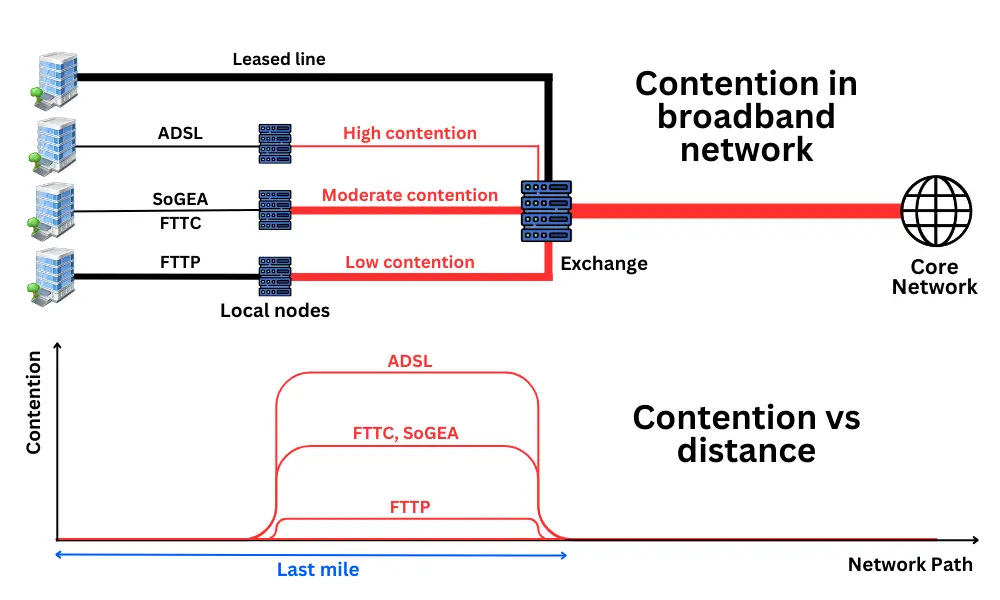Business Broadband Contention
Most UK businesses compete for bandwidth on their broadband connections. They share the same (contended) broadband lines and suffer when traffic exceeds this capacity.
Another portion of businesses opt for leasing private (uncontended) lines unaffected by congestion. But at a much higher price tag and requiring a custom installation and setup.
This guide explores bandwidth contention, why and how it arises, and strategies for mitigating its effects when dedicated lines are not an option.
Contents
- Contended vs uncontended business broadband
- Why does broadband contention happen?
- Contention of typical business broadband connections
- The effects of high contention
- Mitigating high contention in business broadband
Contended vs uncontended business broadband
Business broadband connections can be contended or uncontended. Here are the key characteristics of each:
| Category | Uncontended Broadband | Contended Broadband |
|---|---|---|
| Definition | Dedicated bandwidth exclusively for a single business, unaffected by network congestion. | Bandwidth shared among multiple connections, leading to competition for resources. |
| Connection Types | Leased line broadband connections. | Standard broadband connections: ADSL, SoGEA, Cable, Full Fibre. |
| Performance | Maintains consistent performance regardless of peak traffic times. | Performance may decrease during peak traffic. |
| Infrastructure | Fully dedicated infrastructure with low contention ratios. | Shared infrastructure: DSLAMs in local cabinets for copper connections, Fibre Distribution Hubs for full fibre connections. Contention ratios range from 100:1 (ADSL) to 5:1 (FTTP). |
| Cost | More expensive due to the premium nature of the service. | Cheaper due to shared infrastructure. |
Their distinction lies in technology at the”access layer” or “last mile” of a broadband connection, as outlined in the next section.
Why does broadband contention happen?
Contention is the competition for bandwidth in the “last mile” of business broadband connections, specifically the segment between the premises and the nearest exchange.
In this “last mile” segment, multiple subscribers (both homes and businesses) share limited bandwidth. This shared infrastructure often becomes congested during peak traffic times, reducing broadband performance.
The fiercest competition occurs in the shared segment between “local nodes” (e.g., local cabinets and fibre distribution hubs, where lines from individual premises converge) and the exchange.

Leased line broadband avoids contention by providing a dedicated, private line from the exchange to the premises, bypassing the congested shared infrastructure and ensuring minimal contention.
Contention Ratios
Contention is often expressed using the “Contention Ratio”:
Contention Ratio = Number of connections per backhaul line
This ratio indicates how many subscribers share the journey between local nodes and exchanges. The higher the ratio, the greater the likelihood and severity of performance issues during peak traffic hours.
However, the contention ratio doesn’t tell the whole story, as it doesn’t specify the amount of bandwidth being shared, which varies per technology and local node.
Contention of typical business broadband connections
Let’s examine how contention impacts the performance of different business broadband connections.
The effect of contention on broadband performance depends on several factors:
- The number of subscribers sharing a line in the “last mile” (Contention ratio).
- The bandwidth of the backhaul line.
- The service level agreement (SLA) provided by the broadband provider.
| Connection Type | Contention Ratio | Shared backhaul bandwidth | Agreed speeds | Description |
|---|---|---|---|---|
| Leased Line Business Broadband | 1:1 | Doesn't share any lines in the 'last mile' journey. | 1 - 10 Gbps | No contention ensures consistent, symmetrical speeds and performance, even during peak times, as bandwidth is ample and dedicated to each subscriber. |
| Full Fibre Business Broadband | 5:1 to 20:1 | Tens of Gbps | 100 Mbps - 1Gbps | Lower contention reduces the impact of peak-time congestion, though some slowdown may occur if the network is heavily utilised. |
| Cable Business Broadband | 100:1 to 200:1 | Tens of Gbps | 100 Mbps - 1Gbps | High contention can result in noticeable slowdowns during busy periods, especially in densely populated areas with more suscribers per line. |
| SoGEA | 20:1 to 50:1 | Tens of Gbps | 20 - 80 Mbps | Moderate contention can result in noticeable slowdowns during busy periods, especially in densely populated areas with more suscribers per line. |
| ADSL | 50:1 to 100:1 | Up to 1 Gbps | 1 - 20 Mbps | High contention AND low bandwidth to share. Leads to frequent and severe slowdowns during peak times. |
This underscores the careful balance required to maintain acceptable service levels while maximising the number of subscribers sharing a backhaul line.
Infrastructure providers such as Openreach and KCOM allocate a fixed backhaul bandwidth and impose limits on the number of subscribers. Simultaneously, business broadband providers like BT, Virgin Media, and Daisy manage the real-time traffic of each subscriber line.
Note that business broadband traffic is prioritised over residential broadband connections, which may suffer from bandwidth throttling during periods of excessive traffic.
The effects of high contention
High contention in business broadband can impact business operations in environments that rely heavily on consistent internet performance. The following issues can be expected:
Inconsistent performance
Performance degradation during peak times affects critical online activities such as data uploads/downloads and access to cloud-based services. Latency sensitive tasks like video conferencing (UCaaS) or the quality of VoIP calls may be disrupted.
Operational delays
Reduced bandwidth availability causes delays in time-sensitive tasks, including processing online orders, running digital systems, or collaborating on shared platforms. This inefficiency impacts both internal workflows and customer service.
Scalability challenges
Limited idle bandwidth capacity restricts broadband scalability without upgrades. Adding users, devices, or online services increases bandwidth demand, worsening performance issues and stifling growth.
Higher costs
While standard business broadband with high contention may seem cost-effective initially, it can lead to hidden expenses. Frequent disruptions or poor performance may require upgrades to more expensive options, and long-term business broadband contracts can result in termination fees if changes are needed.
Increased security risks
A congested connection is more vulnerable. Overwhelmed networks are easier targets for DDoS attacks, and security monitoring tools become less effective during periods of high congestion.
Mitigating high contention in business broadband
Many businesses must rely on contended broadband due to the unavailability of dedicated connections or prohibitive leased line broadband prices. However, achieving reliable broadband is possible with the following strategies:
1. Choose the lowest contention broadband
Start by choosing a business broadband service with the highest business broadband speed and lowest contention ratios available.
Compare business broadband deals today to explore the best options available in your area.
2. Implement broadband load balancing
Invest in a secondary connection to allow network load balancing, combining the bandwidth of multiple connections. A multi-WAN business broadband router is required.
Consider combinations including wireless options like 5G broadband for businesses or satellite business internet or added redundancy in case of severe contention on tethered networks.
3. Use Quality of Service (QoS)
Configure QoS settings on advanced business broadband routers to prioritise critical traffic, such as business VoIP phone systems or video conferencing, over less important tasks. This ensures key operations remain unaffected during peak times.
4. Schedule data-intensive activities
Plan bandwidth-heavy tasks, such as file uploads and backups, during off-peak hours (e.g., early mornings or late evenings). This minimises competition for bandwidth during busy periods.
5. Monitor and optimise network usage
Deploy network monitoring tools to identify bandwidth bottlenecks and non-essential activities that consume excessive bandwidth. Implement policies to limit or block unnecessary usage during peak times.

